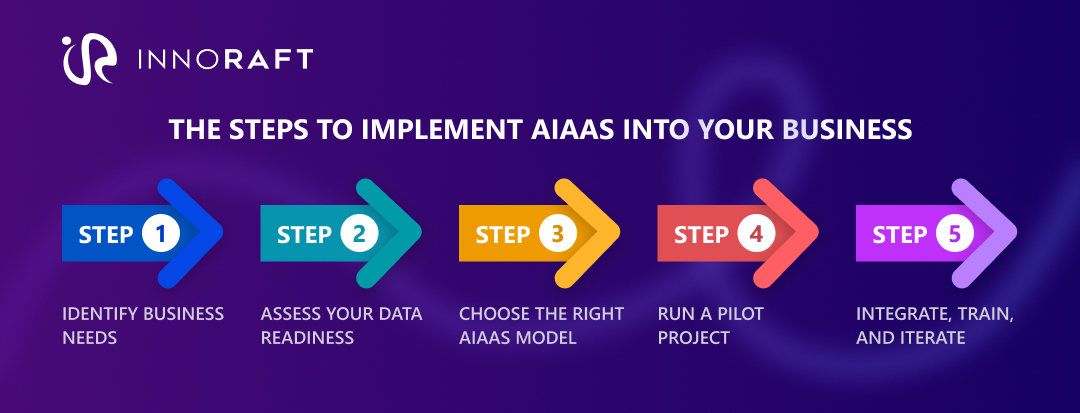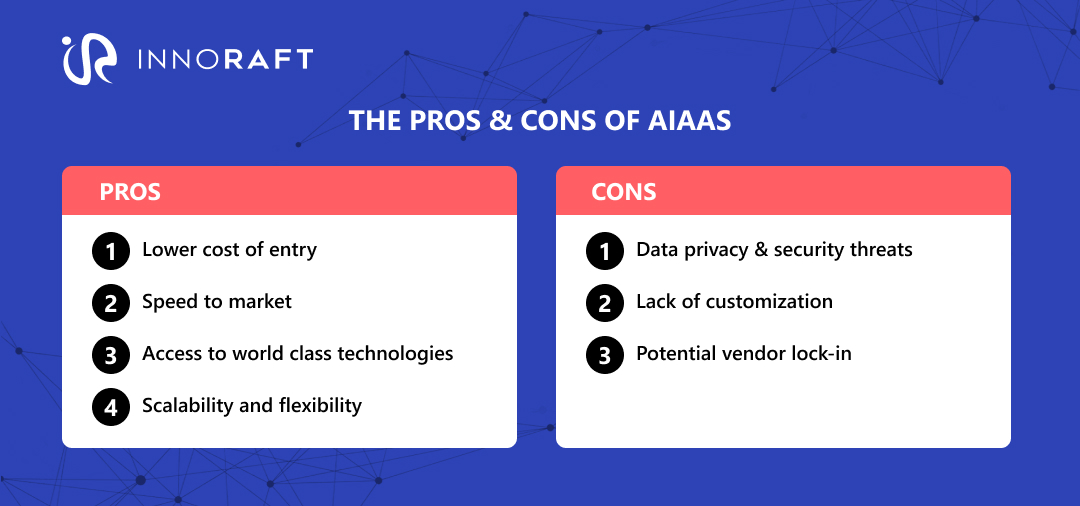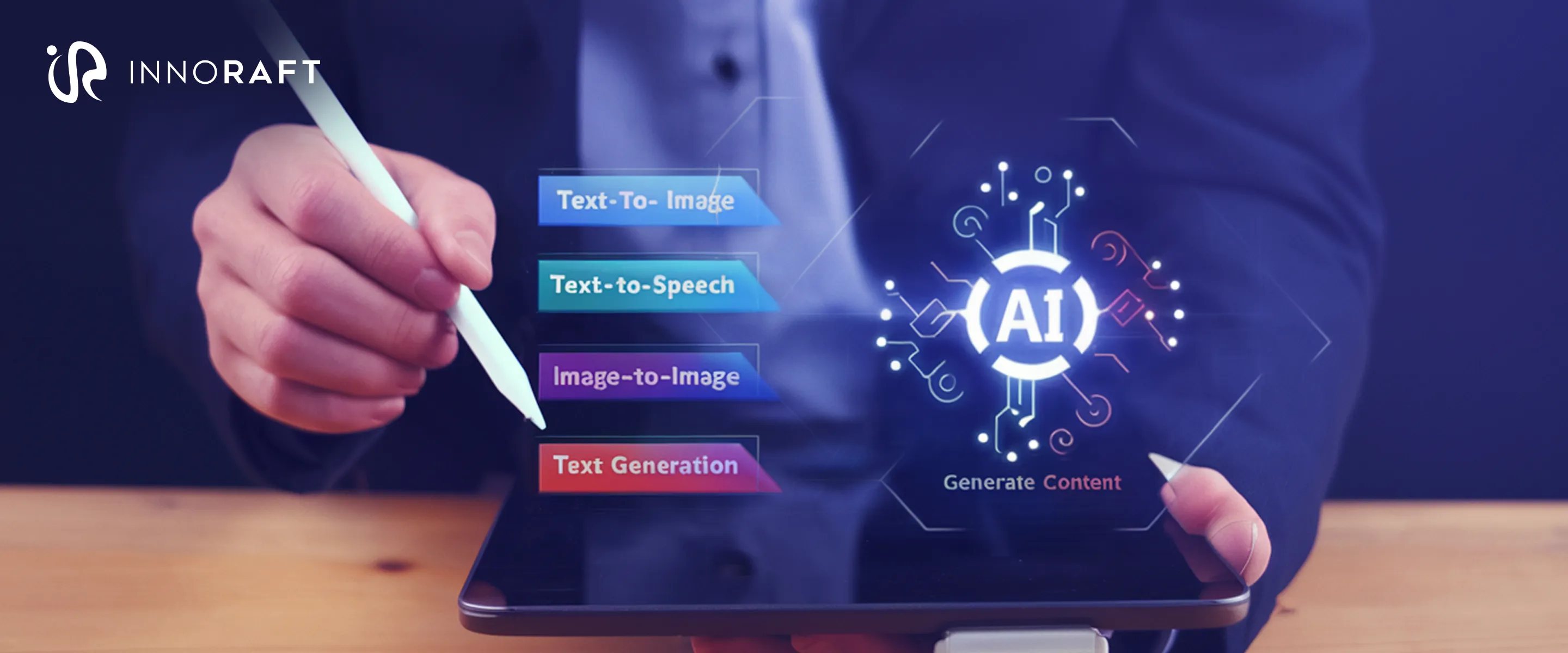Artificial intelligence is no longer some distant frontier. It's already reshaping industries. But for many businesses, especially small to mid-sized ones, the idea of adopting AI feels more intimidating than inspiring. The cost, complexity, and need for specialized talent make it seem out of reach.
And yet, your competitors are using it. They're automating processes, predicting customer behavior, optimizing operations, and doing it without hiring teams of data scientists or building massive infrastructure from scratch.
So how are they pulling it off?
The answer is Artificial Intelligence as a Service (AIaaS).
Think of AI as electricity. You don't need to generate your own power to light your office; you plug into the grid and pay only for what you use. Cloud-based AI services work the same way. They let you tap into powerful AI tools provided by experts, without needing to build the technology yourself. Instead of investing millions into R&D or hiring a full-time AI team, you subscribe to ready-made tools from cloud providers, just like you pay for cloud storage or CRM software.
AIaaS offers scalable AI solutions for companies that previously couldn't afford to play in the AI space. Whether you're running a growing e-commerce brand, a regional logistics firm, or a software startup, AI is now within reach, without the heavy lift.
In the following sections, we'll break down how AIaaS works, how you can implement it, some of the real world use cases, and the pros and cons you must know about.
What Exactly is AI as a Service (AIaaS)?
Artificial Intelligence as a Service (AIaaS) is a way for businesses to access powerful artificial intelligence tools without having to build or maintain any of the underlying infrastructure. It works just like other “as a service” models. You can subscribe to a cloud-based AI service, access the tools you need, and pay based on usage.
You don’t need a team of machine learning engineers or a warehouse full of servers to drive results from AI implementation. You simply use the AI capabilities provided by companies like Amazon, Google, Microsoft, or specialized vendors,often through simple APIs or easy-to-use platforms. This is the core of how AIaaS works.
Common Forms of AIaaS
AIaaS deployment models typically come in three forms, each offering different levels of complexity and customization:
Pre-built APIs for Specific Tasks
These are plug-and-play tools that handle well-defined functions. You don’t need to train anything, just send your data and get results.
Examples:
- Image recognition (e.g., identifying objects in photos)
- Language translation
- Text or speech sentiment analysis
- Document summarization
These are ideal for businesses looking to add AIaaS or function quickly with minimal development work.
Machine Learning Platforms
If you need more control and customization, machine learning as a service (MLaaS) platforms offer the ability to train and deploy your own models. You bring your data and business logic, and they provide the infrastructure, tools, and frameworks.
Examples:
- Google Vertex AI
- AWS Machine Learning
- Azure Machine Learning
- IBM Watson
These are the go to platform If you want custom AIaaS solutions for business investing in complete AI infrastructure.
Ready-Made AI Solutions
These are out-of-the-box tools built for specific business functions. You don’t need any kind of AI-expertise to use them.
Examples:
- AI-powered chatbots for customer service
- Personalized recommendation engines for e-commerce
- Predictive analytics dashboards for forecasting
They’re great for teams looking to leverage real AIaaS use cases quickly, without touching code or algorithms. For early-stage companies, these tools also serve as affordable AI solutions for startups, offering fast value without heavy investment.
Artificial Intelligence as a Service lets your business use advanced AI without investing a significant amount of time and resources. It lowers the barrier to entry, shortens the learning curve, and allows you to start small while thinking big.
How to Implement AIaaS Into Your Business: A Clear Roadmap
You don't need to reinvent your business overnight to implement AI/ML in your web apps or business processes. In fact, the smartest approach is often the simplest: start with a single, high-impact AIaaS use case. Here's a step-by-step roadmap to help you move from concept to execution with confidence.

Identify Business Problems
Start by asking: Where could smarter automation, faster insights, or better predictions make a real difference?
Focus on problems with clear pain points,repetitive manual tasks, inefficient workflows, or gaps in customer experience. A few examples:
- High customer service volume - consider a chatbot.
- Frequent returns in e-commerce - try product recommendation engines.
- Slow document processing - explore intelligent document readers.
This keeps your AIaaS for business projects grounded in real business value.
Assess Your Data Readiness
AI needs data to work. You don't need "big data," but you do need relevant, clean, and accessible data. Ask:
- Do you have data that's already being collected (e.g. customer tickets, sales logs)?
- Is it structured and stored in a usable format?
- Do you have the right permissions to use it?
If you're missing data, some Artificial Intelligence as a Service (AIaaS) tools come with pre-trained models that require minimal customization,a good starting point while your own data grows.
This flexibility is one of the key benefits of AIaaS, especially for businesses just starting their AI journey with limited data infrastructure.
Choose the Right AIaaS Model
Pick the level of complexity that matches your needs and internal resources:
- Need fast results with minimal lift? Use prebuilt APIs or ready-made tools.
- Need tailored insights? Use a machine learning as a service (MLaaS) platform to train custom models.
- Need long-term scalability? Consider a hybrid approach that evolves as your needs grow.
Make sure the provider has solid documentation, customer support, and integration options that work with your tech stack. Choosing from the best AIaaS providers can make a big difference in how smoothly your solution performs and scales over time.
Run a Pilot Project
Before scaling, test on a smaller scale:
- Choose a single team, product, or region.
- Define what success looks like (e.g., reduced processing time, higher conversion rate).
- Measure performance against your baseline.
Running a pilot helps you validate the AIaaS deployment model that fits your business without overcommitting resources. This keeps costs low while giving you space to evaluate real-world impact, one of the most practical AIaaS use cases for early implementation.
Integrate, Train, and Iterate
Once the pilot proves valuable:
- Roll it out more broadly across the business.
- Train relevant teams, both technical and operational, on how to use and interpret results.
- Collect feedback and performance data to refine your setup
Treat it as a process, not a plug-and-play fix. AI improves with iteration, and so do cloud-based AI services as they adapt to your specific workflows. Over time, this approach positions you to take advantage of AIaaS in enterprise environments, where ongoing training and optimization can unlock even greater returns at scale.
The Pros & Cons: Key Benefits and Challenges of Using AIaaS
AIaaS can give your business a competitive edge without the traditional barriers of cost, time, or expertise. One of the major benefits of AIaaS is its ability to deliver advanced capabilities without requiring deep in-house technical knowledge or infrastructure.
But like any technology decision, it comes with trade-offs. From concerns around data privacy to limitations in customization, it's important to assess your priorities carefully, especially when weighing AIaaS vs in-house AI approaches.
Here's what to weigh as you consider adopting it.

Key Benefits of AIaaS
Dramatically Lower Cost of Entry
Building AI from scratch requires expensive infrastructure and highly specialized talent. With Artificial Intelligence as a Service, those costs are absorbed by the provider. You pay only for what you use; no servers, no hiring sprees, no long-term lock-in to internal development.
Incredible Speed to Market
Want to add image recognition or natural language processing to your app? With AIaaS, you can go from idea to prototype in weeks, sometimes days. This agility allows you to test AIaaS use cases quickly without a drawn-out development process.
Access to World-Class Technology
You're leveraging the same AI capabilities used by major enterprises, developed and maintained by leaders like Google Cloud, AWS, and Microsoft Azure. Their platforms are constantly improving, and you benefit without lifting a finger, just by choosing from the best AIaaS providers.
Scalability and Flexibility
As your needs grow, your AIaaS solution scales with you. Add more capacity, features, or data processing power without needing to rebuild anything. This flexibility is ideal for companies with changing or seasonal demands, and makes scalable AI solutions an achievable reality.
Challenges to Consider
Data Privacy and Security
Despite the various benefits of AI analytics, it comes with certain security caveats. And since with AIaaS, you’ll be sending your data to a third-party provider, you need to consider the following questions:
- Where is the data stored?
- Who can access it?
- What security measures are in place?
Ensure your provider complies with your industry's regulations (GDPR, HIPAA, etc.) and offers strong encryption, access controls, and data governance policies. These concerns are especially critical in AIaaS applications by industry, where compliance standards vary widely.
Less Customization
Prebuilt tools are fast and convenient, but they're designed for general use cases. If your business problem is highly specific or niche, you may find that off-the-shelf models don't deliver the precision or nuance you need. This is often a key factor in comparing AIaaS vs in-house AI approaches.
Potential for Vendor Lock-In
Once your systems, data pipelines, and workflows are built around a provider's platform, switching can be painful, especially if you've customized heavily or integrated deeply. Consider:
- Open standards
- Portability of models/data
- Contract terms
This means you should move forward with a long-term view. Evaluating AIaaS deployment models early on can help ensure flexibility down the line.
AIaaS offers significant advantages in cost, speed, and access, especially for small to medium businesses that don't have the resources to build AI themselves. But it's not a silver bullet. The right fit depends on your business needs, data privacy obligations, and long-term flexibility.
Real World Use Cases: How Industries Are Using AIaaS
AIaaS applications aren’t limited to any one sector, it’s showing up across industries in ways that are practical, targeted, and often invisible to the end user. From retail and finance to healthcare and logistics, businesses are putting AIaaS to work in real-world scenarios that drive measurable results.
Here’s a breakdown of AIaaS applications by industry.

Retail & E-Commerce
- Product Recommendations: AIaaS platforms analyze customer behavior and browsing patterns to deliver real-time product suggestions that drive conversions. These are among the most common and effective AIaaS use cases in digital commerce.
- Inventory Forecasting: Retailers use predictive models to optimize stock levels based on seasonality, demand trends, and historical sales data.
- Personalized Marketing: AI-driven segmentation and content optimization tools help tailor email campaigns and on-site experiences.
Healthcare
- Medical Imaging Analysis: Clinics use AIaaS tools for faster, more accurate interpretations of X-rays, MRIs, and CT scans.
- Patient Support Chatbots: Virtual assistants handle appointment scheduling, FAQs, and follow-ups, freeing up administrative time.
- Predictive Health Monitoring: AI models track and analyze patient vitals or behavioral data to flag early signs of complications.
These tools are transforming care delivery and diagnostics, making cloud-based AI services a powerful asset in modern healthcare.
Financial Services
- Fraud Detection: AIaaS models scan transaction patterns in real time to detect and block suspicious activity.
- Credit Scoring: Lenders use machine learning APIs to improve credit assessments, especially for applicants with limited credit history.
- Automated Customer Support: Banks implement AI-powered chatbots to answer common questions and triage requests.
These capabilities reflect the rising adoption of Artificial Intelligence as a Service in enterprise finance environments.
Logistics & Supply Chain
- Route Optimization: AI services help delivery and fleet companies reduce fuel costs and delays by analyzing traffic, weather, and delivery windows.
- Demand Forecasting: Manufacturers use AIaaS to predict material needs and avoid overproduction or stockouts.
- Automated Document Processing: Logistics providers use AI to scan, extract, and process shipping documents and invoices.
These are real-world examples of AIaaS market trends redefining efficiency in operations-heavy industries.
Education & Training
- Personalized Learning Paths: EdTech platforms use AI to adapt content to individual learners pace and performance.
- Automated Grading: Natural language models help assess essays, quizzes, and open-ended answers at scale.
- Chat-based Tutoring: AI-powered virtual assistants answer questions and provide instant feedback for learners 24/7.
These tools illustrate how AIaaS applications by industry are evolving to support human learning at scale.
These aren’t futuristic scenarios,they’re already happening. AIaaS is allowing companies in every sector to automate, personalize, and predict with minimal setup and fast results. The key is choosing the AIaaS use cases that align with your business goals and available data.
Your First Step Into AI
You don't need to build AI from the ground up to start benefiting from it. Artificial Intelligence as a Service (AIaaS) makes powerful, enterprise-grade intelligence available to businesses of all sizes,no PhDs, massive budgets, or years of development required.
Whether it's automating repetitive tasks, improving decision-making, or delivering better customer experiences, AIaaS gives you the tools to solve real business problems, fast. You can start small with off-the-shelf APIs, or explore more advanced platforms when you're ready to scale.
But success with AIaaS isn't just about implementing the technology. It starts with knowing your pain points, understanding your data, and choosing tools that fit your goals and constraints. And while the benefits are lower costs, faster deployment, scalable AI solutions, it's important to plan for challenges like data privacy, vendor reliance, and solution fit.
Here's what to remember:
- You don't need to hire a full AI team, you just need the right use case and the right tool.
- Start small, prove value, and scale with confidence.
- Pay attention to the trade-offs, especially around data ownership and customization.
- AIaaS is not the future, it's already being used by your peers and competitors today.
So the question isn't whether you should adopt AI. The question is: where will it make the biggest impact first?
With AIaaS, the easiest path forward might already be within reach, you just need to take the first step.
Want to know more about how AIaaS can help your business? Contact us for more information!
FAQ
Frequently Asked Questions
Didn’t find what you were looking for here?
